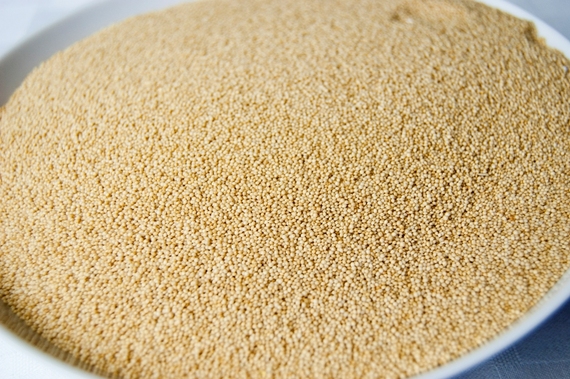Friday, April 22nd is Earth Day 2016 and what better way to celebrate this day than by eating one of the Earth's most potent seeds available, kiwicha. Also known as amaranth or "mini quinoa," kiwicha is a small pseudo cereal noted for its dense nutritional content. kiwicha originates from Peru and has been farmed there and in other areas of South America for over 4,000 years. It was widely used as a subsistence crop before the Spanish conquest.
As a native Peruvian, I've always been driven to share my knowledge about the foods that originate from the region. And as a registered dietitian, I am particularly interested in the health properties of many Peruvian foods. While doing research a few years ago to write my two Peruvian superfood books, I traveled from the fertile farmlands of the Andes, to the depths of the Amazonian jungle to explore several types of foods. Along the way, I visited open markets, restaurants, humble food stands, and family kitchens, stopping to gather stories and recipes from local chefs, food bloggers, farmers, fishermen and abuelitas.
According to locals, it is still regarded for its ceremonial significance. Kiwicha is used in the present day during Day of the Dead festivities; the grain is popped and mixed with sugar to form a candy called alegria, usually in the shape of a small figurine or skull. Kiwicha is also commonly used to prepare turrones, a popular treat made of popped kiwicha and molasses, chicha (kiwicha beer) as well as pilaf, hot cereal, snack bars and granola.
During the 1970s there was a renewed interest in kiwicha for its health and nutritional benefits and it has only continued to gain popularity. Kiwicha is considered an anti-aging food due to its cumulative anti-carcinogenic, anti-hypertensive, anti-oxidant, and anti-lipidemic properties. Kiwicha contain all 10 essential amino acids, making it an optimal plant protein for vegetarians (1). It is also high in the amino acid lysine, distinguishing it from other grains which typically contain very little lysine and need to be combined with other foods to make a complete protein. In addition to being gluten-free, it is high in fiber, iron, phosphorus, magnesium, zinc, and manganese (1).
Kiwicha contains phenolic acids, carotenoids, and flavonoids which impart antioxidant properties (1). It also contains squaline, an organic compound found in some plants, which acts as an anti-cancer agent and may be cardio-protective as well due to its ability to lower LDL, total cholesterol, and triglycerides. A half cup serving of cooked kiwicha provides 125 kcal, 4.7 grams protein, 2 grams of fat, 23 grams of carbohydrate, and 2.5 grams of fiber (2).
This Earth day, go green by adding Kiwicha to your diet to boost health and vitality. Since it could be used as a cereal, it saves on wasting cardboard boxes from major brand cereal boxes. As a complete protein source, it provides an alternative to animal based protein or meat, also cutting down on carbon emissions. But remember, there is no one miracle food. By adding a variety of nutrient-rich superfoods to a smart diet of whole grains, fresh fruits, lean meats and good fats, you can jump start your health and increase your longevity. The recipe and video below are a great way to explore this incredible superfood.
Superfoods Bowl Breakfast Cereal
Serves: 1
Ingredients
For popped kiwicha
3 tablespoons raw kiwicha
For breakfast cereal
1 ½ cup popped kiwicha
½ cup strawberries, sliced
½ cup blackberries, halved
1 tablespoon walnuts, chopped
1 tablespoon chia seeds
1 tablespoon cacao nibs
1 tablespoon honey
Directions
- Heat a medium frying pan over high heat until the entire surface of the pan is hot. Add 1 tablespoon of kiwicha to the pan (no oil is needed): shake and distribute evenly across the surface. Cover the pan with a lid. Allow the kiwicha to "pop" and turn white in color, for roughly 30 seconds, making sure to shake the pan over the heat to avoid burning. When the kiwicha is popped, pour into medium sized bowl to cool.
- Repeat step 1 using the remaining 2 tablespoons.
For the breakfast cereal
1.Put the popped kiwicha in a bowl. Top with strawberries, blackberries, walnuts, chia seeds, cacao nibs, and honey.
Note: Serve with milk of choice
Recipe and photos by Manuel Villacorta, MS, RD
Manuel Villacorta is a nationally recognized, award-winning registered dietitian/nutritionist with more than 18 years of experience. He is a trusted voice in the health and wellness industry. He is the author of Eating Free: The Carb Friendly Way to Lose Inches, Embrace Your Hunger, and Keep Weight Off for Good (HCI, 2012) Peruvian Power Foods: 18 Superfoods, 101 Recipes, and Anti-Aging Secrets from the Amazon to the Andes (HCI, 2013) and his newest book Whole Body Reboot: The Peruvian Superfoods Diet to Detoxify, Energize, and Supercharge Fat Loss (HCI, 2015).
References:
1. Amaya-Farfan, J. & Caselato-Sousa, V. (2012). State of knowledge on Amaranth grain: A comprehensive review. Journal of Food Science 77, no. 4.
2. National Nutrient Database for Standard Reference. (2005). Full report (All Nutrients): 20002, Amaranth grain, cooked. Agricultural Research Service United States Department of Agriculture, Release 26.
